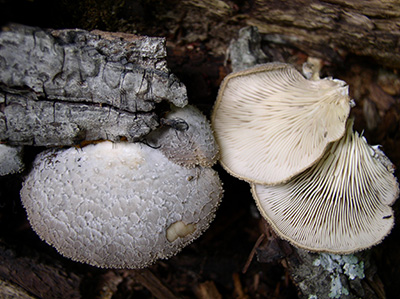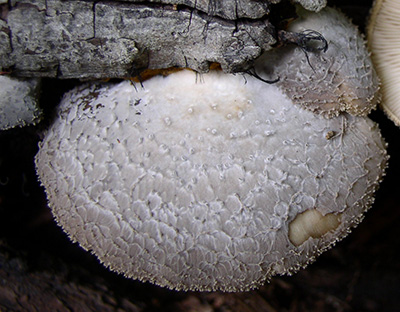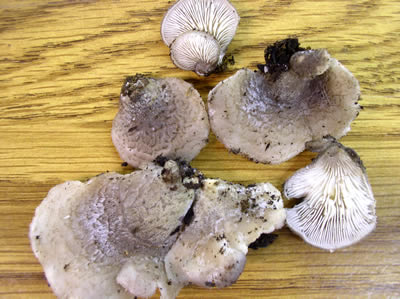Hohenbuehelia mastrucata
Scientific name: Hohenbuehelia mastrucata (Fr.) Singer;
Derivation of name: TBD
Synonyms: Pleurotus mastrucatus (Fr.) Sacc.
Common name(s):
Phylum: Basidiomycota
Order: Agaricales
Family: Pleurotaceae
Occurrence on wood substrate: Saprobic; solitary
or in clusters
on logs and stumps of hardwood trees,
especially maple; summer through fall.
Dimensions: Caps up to 7 cm wide.
Cap: Dark gray to brownish-gray to bluish-gray, fading
to gray; convex to almost flat, semicircular to
kidney-shaped; with a rubbery, tougher texture due to a
gelatinous layer below the cuticle; cap covered with
thick, gelatinous conical spines or ridges in a net-like
(reticulum) pattern.
Gills: Close or distant, whitish to grayish; margins even.
Spore print: White.
Stipe: Absent or nearly so.
Veil: Absent.
Edibility: Unknown.
Comments: As with Pleurotus species, Hohenbuehelia
species supplement their
diet by capturing nematodes
their hypahe encounter in the rotten wood.
Confident identification of closely related Hohenbuehelia
species often requires examination of microscopic
characteristics.
More Information at MushroomExpert.com

Figure 1. Brownish-gray caps and whitish gills of
Hohenbuehelia mastrucata.
Photo © Fred Habegger.

Figure 2.
The cap is covered with a net-like pattern of
gelatinous
conical spines and ridges.
Photo © Fred Habegger.

Figure 3. Hohenbuehelia mastrucata specimens showing a
narrowing of the cap at the point of attachment but the
virtual absence of a stipe. Photo © Dorothy Smullen.